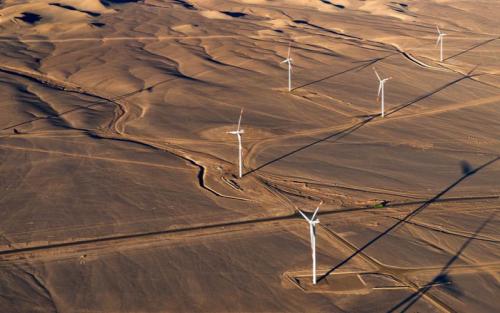Latin America's post-pandemic energy transition
The energy transition in Latin America is underway. Government incentives and continued Chinese investments and loans will be critical to its development.
- Análisis

The global change in the energy matrix gained momentum in the 2010s thanks to technological advances in electricity generation with renewable energies; international agreements favour the environment and climate change. Technological innovation, led by China, seeks to mitigate greenhouse gas emissions by replacing fossil fuels in power plants with biomass, hydropower and nuclear, solar and wind energy. Latin American countries are in the process of changing the global energy matrix and have made several advances.
However, the COVID-19 pandemic paralysed the world and the economy. Latin America was no exception, and it seems that this may have put the brakes on renewable energies. What happened to the change in the Latin American energy matrix?
In the region, several countries have public policies for the care of the environment and promoting renewable energies. Almost all countries highlight plans to adopt renewable public transport, issuing tenders for clean energy projects, and reduce taxes on energy projects.
Argentina and Uruguay are the countries that have taken the most action for the energy transition. The former has an energy matrix based on coal and fossil fuels but active investments in solar parks and electric cars. Uruguay has one of the cleanest energy matrixes in the region due to its extensive use of hydroelectric and wind farms. On the other hand, it is remarkable that Brazil, Bolivia, Colombia and Mexico have so many fiscal incentives to change their energy matrix when a large part of their budgetary revenues and exports depend on oil and natural gas.
With a framework for action by Latin American governments, the outlook for renewables by 2022 is encouraging. In transport, momentum seems maintained, but it is a bit more complicated in some countries in electricity generation.
The strategy for electromobility is a priority in Latin America, according to the United Nations. Some argue that electric mass public transport is a crucial industry for recovery from the crisis, especially for Mexico and Brazil, which assemble vehicles significantly. At the beginning of 2021, there are 1,230 electric buses in circulation in Latin America, and Chile has the most vehicles on the move: 452. Brazil follows it with 250 and Mexico with 238. Most of these come from China, which could change in the future. There are three factories of the Chinese company BYD for the assembly of electric buses and lithium batteries in Brazil, Argentina and Colombia. The first electric buses started to be assembled in Sao Paulo in March 2021 and are already in circulation. There is also a Brazilian company, Marcopolo, which, together with BYD, has set up an electric bus factory in Colombia.
Electric generation requires new solar and wind farms and the renovation of old hydroelectric power plants. Electric energy sources are essential to see the progress of energy transition. Electricity is the most demanded energy source by modern societies.
The country with the cleanest electricity generation in the region is Uruguay. Since 2012, it has started to reduce fossil fuels for electricity and replaced them with wind energy. Currently, 40% of electricity is generated by wind power. On the other hand, Mexico, Bolivia and Argentina use natural gas, coal and oil. In Mexico, fossil fuels remain the primary energy source, while solar and wind farms are growing. Solar energy tripled in three years due to the installation of European-invested solar parks with Chinese technology. There is growing nuclear, wind, and solar power in Argentina, but coal remains essential. The Argentine Government must rethink the strategy if the progress of renewables in the country is not to be lost.
In Colombia, hydroelectric power plants are the highest in the region, but on a downward trend, with a contra factual increasing use of coal. In contrast, there are increasingly more hydropower plants in Peru due to significant Chinese investments since 2016. Nevertheless, the new government of President Castillo declared that it would exploit more natural gas.
The energy transition in Latin America is underway. Government incentives and continued Chinese investments and loans will be critical to its development. Overall, it seems that the process has not stopped despite the pandemic. However, it will be necessary to follow the cases of Colombia, Peru, Argentina and Mexico, which have seen a significant increase in their energy consumption.
The energy transition in Latin America is underway. Government incentives and continued Chinese investments and loans will be critical to its development. Overall, it seems that the process has not stopped despite the pandemic. However, the cases of Colombia, Peru, Argentina and Mexico, where the process has been more challenging, will need to be monitored. Governments will seek the energy transition to cushion the fallout from the crisis, but this will not be possible without well-structured recovery plans.
Num.26, Year 2021, September 9th
- Carlos de León: Postgraduate Faculty of Economics, UNAM, member of obela.org
- OBELA: Oscar Ugarteche (Coord), Armando Negrete, Bertin Acosta, Jorge Zavaleta, Joselin García
Del mismo autor
- Financing for Latin America's energy transition 15/12/2021
- Financiamiento para la transición energética latinoamericana 14/12/2021
- ¿Una crisis económica en China? 21/10/2021
- An economic crisis in China? 21/10/2021
- Latin America's post-pandemic energy transition 14/09/2021
- La transición energética latinoamericana pospandémica 14/09/2021
- Transporte terrestre chino en América Latina 02/06/2021
- Chinese land transport in Latin America 02/06/2021
- Chinese ports and docks in Latin America 06/04/2021
- Puertos y muelles chinos en América Latina 06/04/2021
Clasificado en
Clasificado en:
Crisis Ambiental
- Paula Bianchi 07/04/2022
- Leonardo Boff 05/04/2022
- Gabriela Ramírez, OBELA 04/04/2022
- Gabriela Ramírez, OBELA 04/04/2022
- Aviva Chomsky 28/03/2022








